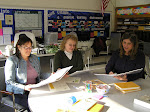Reader One: Running Water
Reader Two: The source, or beginning, of a stream is in the hills. The clear water trickling out of the ground is joined by other streams and soon a small torrent is gushing down the valley.
Reader One: A “torrent” is fast moving water.
Reader Two: As it swirls around the boulders, its force carries smaller stones along with it.
Reader Three: Few plants can root or grow in the tugging water, but willow moss may coat some boulders.
Reader One: Willow moss is called an aquatic plant because “aquatic” means having to do with water.
Reader Two: A casual glance into the stream will detect no life, but closer examination will uncover animals who have learned to live with, or have adapted to, these conditions.
Reader One: In this sense, to adapt means that a species of plant or animal has changed from generation to generation over time in order to survive in this environment.
Reader Three: The stonefly nymphs can live in running water and feed on leaves and debris carried by the current. They in turn are food for the trout.
Reader One: A nymph is an immature form of an insect. It resembles the adult in basic form but undergoes some change as it develops. This is called incomplete metamorphosis.
Reader Two: Most animals living in these streams are flat so they can shelter under stones from the strong current.
Reader Three: If the flow is not too fast, little fish like the bullhead may make a home under the stones. Not many fish like strong flowing streams, but the trout with its streamlined, torpedo-shaped body, can swim against the current.
Reader Two: Other living things in the stream have suction pads to hold them to the rocks.
Reader Three: Caddisfly larvae glue their homes made of sand or plant debris to the rocks. Some do not build a case, but spin a net to catch food and to stop them from being washed away.
Reader One: Unlike the nymph, a larvae is very different from its adult form, so it goes through a complete metamorphosis.
Reader Three: A swift stream can also be home to the dipper, the only bird that can walk underwater. With its wings partly spread to hold it down, it searches the bottom for insects to eat.
Reader Two: No matter what environment you consider, it is teeming with a variety of life forms.
Staging: Reader One is the definer, Reader Two presents the concepts and Reader Three presents the plants and animals. Reader Two stands between One and Three. The Readers should make gestures that are representative of the movement of the stream and animals, but when Reader One reads, the other two readers should freeze. Illustrations could be used if large enough but not so large that they are distracting. Another possibility is putting the illustrations in a PowerPoint and project it above the readers.
Source Material Primarily: Stidworthy, John. Ponds and Streams. Nature Club Series. Mahwah, NJ: Troll Associates, 1990.
Tuesday, March 11, 2008
Subscribe to:
Post Comments (Atom)

No comments:
Post a Comment